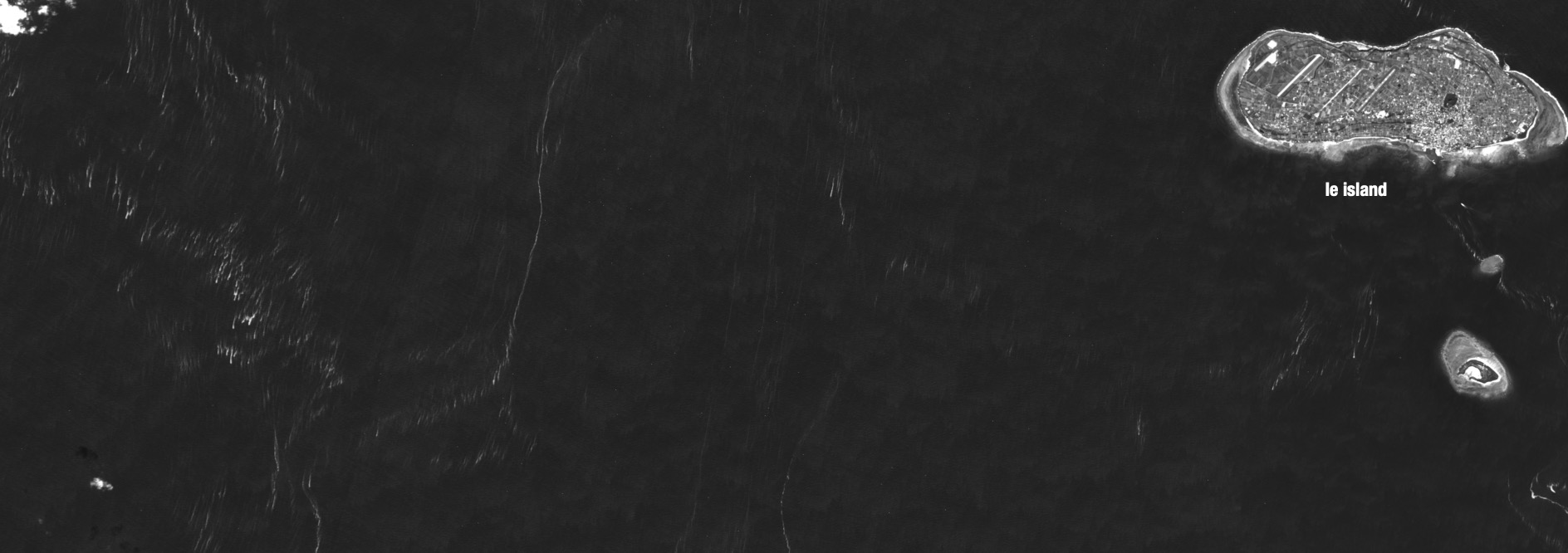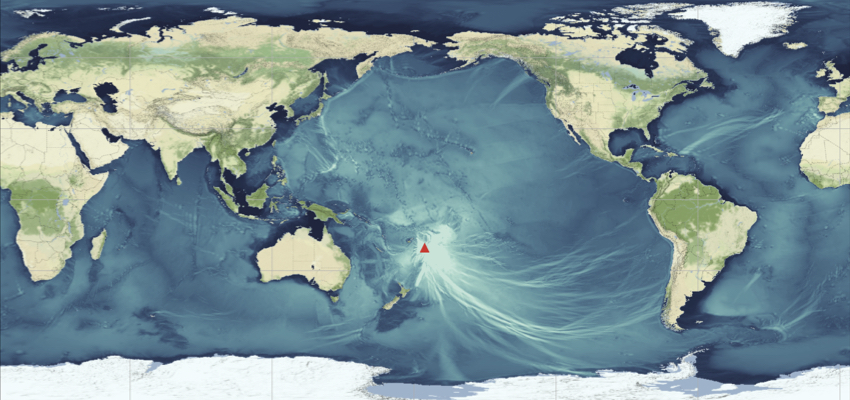FY2021 Annual Report
Shocks, Solitons and Turbulence Unit
Associate Professor Emile Touber

Abstract
The Shocks, Solitons and Turbulence (S2T) Unit carries out theoretical and computational studies of energy transfers and transport arising from shock/solitary waves and turbulence. We work on a variety of problems (from cosmic to biological scales) expressed in terms of (i) fields obeying some form of conservation laws, (ii) closed using physics-based or simple behavioral arguments, (iii) and found in a turbulent and/or shocked regime.
This report highlights some key moments of the fiscal year. This year we launched projects ranging for the study of waves in small biological networks (slime mould) to waves the size of Earth (Tonga eruption). Every project we run is centred around modelling and simulation efforts together with experimental observations. Not being experimentalists ourselves, we invested significant ressources (e.g. manpower time, equipments, data) and collaborative efforts to acquire observation data of the complex dynamical processes we study.
1. Staff
- Emile Touber, Associate Professor
- Adel Rodriguez, Postdoctoral Researcher
- Roman Mukhin, Technician
- Stephen Winn, Technician
- Yussuf Ali, Technician
- Andre Krichikov, Technician
- Saori Chappell, Research Unit Administrator
2. Collaborations
2.1 Surface slicks: how do they form, where do they go, how do they disappear?
- Description: Study of the dynamics of ocean surface slicks, whether of biological (e.g. metabolic, coral spawning) or volcanic (e.g. pumice stones) origins.
- Type of collaboration: Joint research
- Researchers:
- Professor Vincent Laudet, OIST
- Professor Satoshi Mitarai, OIST
- Professor Tim Ravasi, OIST
2.2 Slime mould: wave patterns in Physarum Polycephalum
- Description: Experimental and numerical study of wave patterns in slime moulds.
- Type of collaboration: Joint research
- Researchers:
- Professor Sam Reiter, OIST
2.3 Space weather
- Description: Impact of the solar activity on the Earth's upper-atmosphere.
- Type of collaboration: Joint research
- Researchers:
- Professor Ryuho Kataoka, NIPR (Tokyo)
- Professor Hiroko Miyahara, Musashino Art University (Tokyo)
2.4 dNami: Computational framework to solve systems of balance laws
- Description: In-house solver developed in collaboration with CNAM/ENSAM (France).
- Type of collaboration: Joint research
- Researchers:
- Professor Nicolas Alferez, CNAM/ENSAM (Paris)
3. Activities and Findings
The S2T unit is particularly interested in how physical principles such as mass conservation, momentum and energy transfers, work to produce nonlinear wave phenomena and some form of order in chaos. We study these questions in both inactive (e.g. fluid) and active (e.g. bio-active) substances.
3.1 Waves in geophysical flows
This year the S2T unit worked on three types of geophysical flows
3.1.1 Surface slicks
Surface slicks are distinct patches of water on the sea surface. They are made visible due to their ability to damp gravity-driven waves, giving them a smoother apparence than the neighbouring waters. They form, move around, and vanish. During their lifecycle they host their own ecosystem and therefore have recently attracted much interests from marine biologists. In particular, due to their apparent ability to host large concentrations of fish larvae in the open ocean. At the S2T unit we are interested in their dynamical properties: how do they form, how do they move, how do they vanish?
To answer these questions we combine observation and theoretical considerations. For the observation part we use remote-sensing techniques: webcams, drones, and satellite data. Below is an example of surface slicks evolving in the course of a day, as seen by webcam data projected on a plane:
Based on continuous monitoring of the Onna lagoon over a year, we can infer some characteristics of the slick lifecycle: different production, propagation and breakup mechanisms.
On the theoretical side, we model slicks as continuum media with different thermo-physical properties than the surrounding water/air, and use shallow-water-like equations to model their dynamical properties. We are interested in whether such system can create patterns which then significantly change their lifecycle.
In August 2021, the project changed course following the eruption of the Fukutoku-Okanoba underwater volcano. Indeed, by mid-October the Okinawa islands received very large amounts of pumice stones. The stones create rafts very similar to the surface slicks we originally study, which are of biological origin. For modellers like us, this presented us with the unique opportunity to extend our models to slicks made of floating stones, with nature providing the experiment. Some of the interesting dynamics captured by the webcam is shown below.
On large scales, the surface slicks of biological origin form mesh-like structures, and the pumice-made slicks fragment into streaky structures.


We apply our models to explain the mechanisms responsible for such structures so as to deliver predictive models of slick dynamics, of interest to biologists, ecologists and disaster-prevention/mitigation agencies.
3.1.2 Meteotsunamis
On 15 January 2022, the Hunga Tonga Hunga Ha'apai volcano near the Tonga islands erupted and triggered the most powerful meteotsunami ever observed in the satellite-data era.
The atmospheric pressure wave the explosion produced rippled several times around the globe, producing in its wake tsunamis called meteotsunamis. Whilst regular tsunamis are locally generated by the sudden motion of the sea bed, the meteotsunamis generated by the atmospheric wave occurred everywhere around the world, at difficult-to-predict times.
We derived a new set of coupled air-water equations to capture such phenomenon, and solved them using dNami, our computational framework. Below is an animation of such simulation and a map of the maximum predicted wave heights, which are found to be in good agreement with tidal data.

We hope that our model can be used to improve tsunami warning systems.
3.1.3 Solar wind and pine-wilt-disease outbreaks
Together with visitors from the National Institute of Polar Research and Musashino Art University, we learn about solar wind and its effect on Earth. In particular, we found a link between solar cycles and the cyclic nature of pine-wilt-disease outbreaks on Okinawa.
We work with local government and satellite compagnies to establish reliable and uniform monitoring of the disease. Combining our findings with the monitoring system we develop, we hope to enable targeted interventions on the ground to control the spread and save the Ryukyu pine trees.
3.2 Waves in biological networks
This year the S2T unit worked on peculiar wave phenomena in three types of networks
3.2.1 Road networks
We are interested in modelling traffic flows, and in particular the mechanisms behind stop-and-go waves, which are deadly phenomena on road networks. We relate the phenomena to peculiar waves observed in fluids near a phase transition.
To develop our models, we work on a mobile application to record and log trips from members of the public, as well as track experiments. For example, below are footages of the experiments we conducted with volunteers:
The theories we develop can help improve the algorithms used in self-driven cars and offer physics-based strategies to ultimately eradicate traffic jams in the near future.
3.2.2 Slime mould
We are interested in understanding how local contraints associated with a chemical reaction in living organisms translate to large-scale dynamics which can turn into useful/practical features. For example, we are fascinated by the capabilities of slime moulds to explore its environment. These are rooted in the transport of compounds across the network they create. We develop reaction-diffusion models to recreate such dynamics and pose theoretical questions about the connection between complex features on the global scale and the local mechanism responsible for it.
To test some aspects of the model we run experiments with Physarum Polycephalum in the lab. Below is an example of Fourier modes extracted from time-lapse showing directional and large-scale motions throughout the network. We try to understand from very simple considerations how such coherence is achieved and made robust.
3.2.3 Forest
Forests are very complex ecosystems. In this project we focus on individual trees and their role as a node within a network of connected trees. We study theoretically the dynamical properties of this network. In particular, we ask if such network can generate large-scale features which could benefit individual nodes.
To provide some context to our theories, we are developing sensors to monitor the daily expansion/contraction of individual tree trunks, a proxy for sap flow. We aim at equipping hundreds of trees in target sites on Okinawa and Europe. More on this next year!
3.3 Waves in thermo-acoustic engines
The S2T unit is developing a simple apparatus to study how forced acoustic waves in confined geometries (e.g. tubes, loops) can generate thermal gradients. The apparatus is used to validate theoretical models we develop aimed at maximising the thermal gradient for a given energy input. We aim at producing cold temperatures efficiently with simple, sustainable and environmentally-friendly devices.
3.4 dNami public release
We released a first version of dNami! Please check the GitHub repository:
https://github.com/dNamiLab/dNami
4. Publications
4.1 Journals
- Kataoka R., Winn S.D., Touber E. Meteotsunamis in Japan associated with the Tonga Eruption in January 2022. SOLA, doi:10.2151/sola.2022-019
- Miyahara H., Tokanai F., Moriya T., Takeyama M., Sakurai H., Ohyama M., Horiuchi K., Hotta H. Recurrent Large-Scale Solar Proton Events Before the Onset of the Wolf Grand Solar Minimum, Geophysical Research Letters, doi: 10.1029/2021GL097201
- Kataoka R., Nakano S. Reconstructing Solar Wind Profiles Associated With Extreme Magnetic Storms: A Machine Learning Approach, Geophysical Research Letters, doi: 10.1029/2021GL096275
4.2 Books and other one-time publications
In the news:
- The pumice around Okinawa: how long will it last and where will it go?
https://www.oist.jp/news-center/news/2021/12/22/pumice-around-okinawa-how-long-will-it-last-and-where-will-it-go - From the Earth's core to Okinawa's coastline
https://www.oist.jp/news-center/media-links/earth’s-core-okinawa’s-coastline
https://globe.asahi.com/article/14593582 - Interview with Okinawa TV news on March 17th, to discuss the meteotsunami produced by the Tonga eruption
4.3 Oral and Poster Presentations
- Mitarai S., Nakamura M., Nakajima Y., Touber E., Winn S. Towards modeling propagule dispersal of corals, seagrasses, macroalgae, and mangroves, Presentation, Japan Geoscience Union Meeting 2022
5. Intellectual Property Rights and Other Specific Achievements
Nothing to report
6. Meetings and Events
6.1 Aurora and space weather forecast
- Date: December 9, 2021
- Venue: OIST Campus Lab4
- Speaker: Prof. Ryuho Kataoka (National Institute of Polar Research)
7. Other
Nothing to report.



